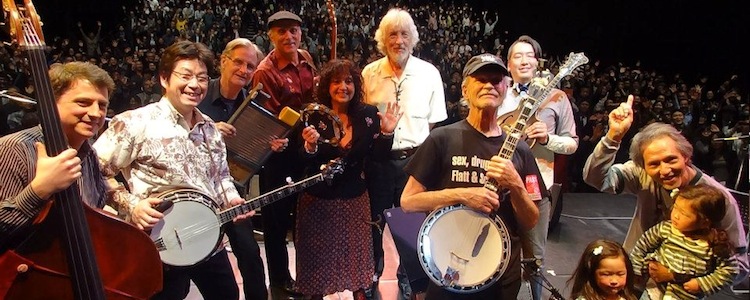

|
HOME TOUR PHOTOS MUSIC VIDEO PRESS JUG BAND EMAIL LIST BOOKING |
|
The Jim Kweskin Jug Band There has never been another group like Jim Kweskin and the Jug Band. The original "Americana" band, playing everything from classic blues to hillbilly country, ragtime, jazz, and rock 'n' roll, they perfectly captured the legendary 1960s mix of exuberant anarchy and heartfelt sincerity. Their imitators were legion, including a San Francisco jug band that became the Grateful Dead and a New York jug band that became the Lovin' Spoonful, but no other group attained their unique blend of youthful energy and antiquarian expertise, tight musicianship, loose camaraderie, and infectious swing. The looseness was partly an illusion - they assiduously sought out long-forgotten records, worked out innovative arrangements, practiced hard, and maintained a high standard of technical skill - but when they played it always felt like play rather than work. They revived the jug band style of the 1920s and made it sound fresher than ever. As Kweskin said, "We don't sound like anybody ever sounded before. What we are doing is taking old styles and building new things out of them. We're ourselves all the time." The Memphis musician and producer Jim Dickenson, who had put together his own group under the tutelage of the legendary Gus Cannon of Cannon's Jug Stompers and Will Shade of the Memphis Jug Band, recalled, "When I heard the Kweskin bunch it blew me away. I couldn't understand how a bunch of guys from Cambridge, Massachusetts got so much closer to the spirit of that music than we could." Where other folk-blues revivalists were nostalgic, the Kweskin gang were revolutionary hipsters. "We were a family, and we were dedicated to presenting a life experience and pioneering experiences for people," says Geoff Muldaur. "We were trying to get that kid in the fourth row to finally pick up a guitar or take a trip - or just get down." Other bands amazed or impressed their fans; the Kweskins made you feel like you wanted to jump onstage and join them. "The whole trip was so innocent," Maria Muldaur recalls. "We just did it like crazies and got up there and sang... It was just a pure love of music and a real community feeling." That family and community centered around Jim Kweskin, a formidable ragtime blues guitarist with his signature black mustache and a gift for good-time jazz. He pulled together a mismatched bunch of talented individuals who often seemed like they had ended up onstage together accidentally and were thrilled and amazed to get along so well and sound so good. Members came and went, but the foundation was always Fritz Richmond, jug player extraordinaire and "poet of the washtub bass." Kweskin handled the upbeat songs, while Geoff Muldaur sang slow blues with eerie soul and added a second guitar, mandolin, or washboard percussion. Maria Muldaur played fiddle, kazoo, or tambourine and sang like a cross between a hillbilly lass and an old blueswoman. Other cast members included Mel Lyman, Bruno Wolfe, and the virtuosos Bill Keith on banjo and Richard Greene on fiddle; both Bill and Richard revolutionized bluegrass technique for their instruments while performing with the Bill Monroe band. Fifty years down the road, Kweskin and the Muldaurs have kept making music in myriad configurations, and they've all staked out plenty of territory since their jug band days. But the Jug Band is where they started, and there is a special magic when they come back together. The rock critic Ed Ward once listed the most important bands of the early 1960s as the Rolling Stones, the Beatles, the Byrds, and the Jim Kweskin Jug Band. Apparently thinking that some people might be surprised to find the Kweskin gang on that list, he added: "I'm not kidding." No one who has ever seen the Jug Band would have thought he was.
Geoff Muldaur was already a known factor when he joined the jug band, and he went on to lend his soulful vocals and brilliant arranging skills to a wide range of influential groups, from Geoff and Maria to Paul Butterfield's Better Days to his own dazzlingly varied solo ventures. He returned from a dozen-year hiatus in 1998 with the acclaimed Secret Handshake, proving his skills were stronger than ever, and has since been touring widely, recording everything from blues and jug band music to an album of Bix Beiderbecke arranged for horn octet. Fifty years on, his singing remains uniquely powerful; as the English folk-rocker Richard Thompson said: "There are only three white blues singers, and Geoff Muldaur is at least two of them." Maria Muldaur is best known for her 1974 mega-hit, "Midnight at the Oasis," which received several Grammy Nominations and enshrined her in the hearts of Baby Boomers everywhere. Despite her considerable pop success, her 50-year career could best be described as an adventurous odyssey through various forms of American Roots Music. During the folk revival of the early 60's, she began exploring and singing early Blues, Bluegrass, and Appalachian "Old Timey" music, beginning her recording career in 1963 with the Even Dozen Jug Band. She then joined the Jim Kweskin Jug Band, touring and recording with them throughout the '60's. In the 40 years since "Midnight at the Oasis," Maria has toured extensively worldwide, and recorded 40 solo albums, covering Jazz, Big Band, Gospel, Jug Band Music, settling comfortably into her favorite idiom, Blues, in recent years, and causing her to often be referred to as "The First Lady of American Roots Music." In 2009, Maria revisited her jug band roots with Maria Muldaur and Her Garden of Joy, a Grammy-Nominated jug band album featuring John Sebastian, David Grisman, and Dan Hicks, and talented musicians from the "New Jug Generation." |
Booking: Steve Fugett, Road Warrior Agency, roadwarrioragency@gmail.com, 615-852-5508 |
|
© Jim Kweskin 2012-2014 |